
Spices
- Home
- Spices
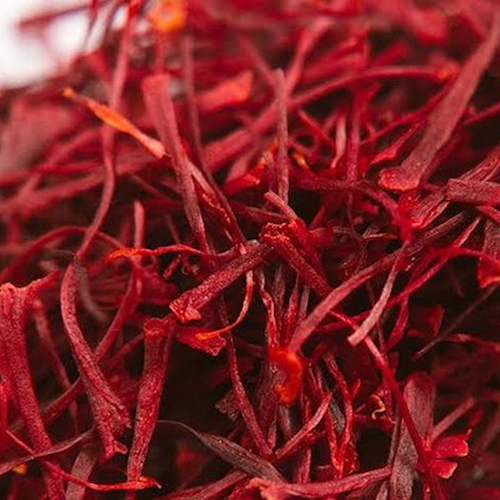
Kashmiri Mongra Saffron
The deep amber and aromatic long strands of Mongra Saffron from Kashmir set it apart from other varieties of this spice. Saffron is known as the “King of Spices.” Saffron is actually the Stigma of a Saffron flower. When the style is separated completely from its Stigma, we get dark red and silky, separated Stigmas and this is what is Mongra saffron. The Kashmiri saffron has been accorded with a GI tag (#635).
Mongra Saffron contains 10% more pigment in comparison to other two marketed forms of Saffron (i.e. Lacha and Guchi Saffron). In a market flooded with chemical-infused, adulterated saffron, we work directly with farmers to source the saffron from farms that practise regenerative agriculture.
Saffron contains several plant-derived chemical compounds that are known to have been antioxidant, disease preventing, and health promoting properties. Kashmir Mongra Saffron strands are added to several delicacies. Kashmiris use saffron to make their unique hot beverage, the Kahwa. They also use it in making a spice cake called Kashmir Ver.

Gandrayan
Gandrayan (Smooth Angelica) is a high-altitude herb of Uttarakhand, also known as Chora. It is a mountainous and tropical region herb that has been used in food recipes of Uttarakhand for centuries. It is a dry root which is used for seasoning curry or lentils in Kumaon and Garhwal regions of Uttarakhand, and also used to enhance taste and flavour.
At altitudes between 2700m and 3000m, farmers grow it with traditional chemical-free methods in alpine scrub and forest shades. It requires deep, rich, porous and moist soil with shady situations. For ideal cultivation, organic manure is required in plenty.
It is specially used in the preparation of Gahat Ki Daal (horse gram) by the people of Uttarakhand during winters. It is said that the use of Gandrayan changes the tahseer (effect) of the food. It is a plant described in Ayurveda and is used in curing various skin diseases, insect bites and helps remedy indigestion, stimulate appetite, and reduce fever.
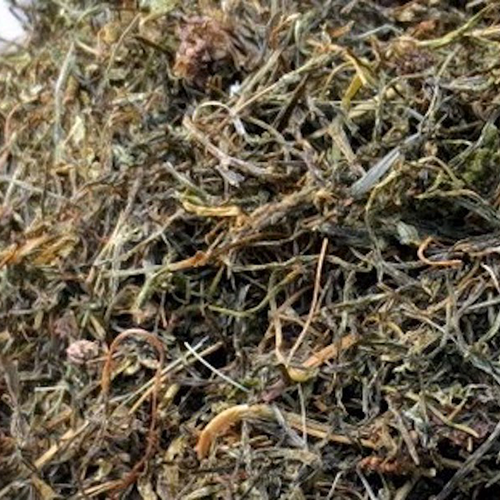
Jimbu
Also known as Himalayan aromatic leaf garlic, Jimbu is a dried aromatic herb that is virtually unknown outside the Himalayan region. The herb looks like dry brownish-green grass and has a distinct flavour, somewhat like garlic and shallots. It is found wild throughout many regions of Nepal and Uttarakhand.
The farmers carefully hand-pick the green and tender foliage from the Jimbu plant in the field and the wild. It is harvested between July to September. After collection, the green Jimbu is brought back to villages and spread on dry mats in a well-ventilated covered shady area. Jimbu harvesters believe that drying in direct sunlight makes poor quality Jimbu without colour and flavour.
The distinct aroma of the herb is nearly lost in the drying process but can be revived to maximum flavour by browning it in hot oil until fully fragrant before using in dishes such as dal, lentil stew, or vegetables. Generally, a pinch of Jimbu is sufficient to infuse a dish with incredible flavour. It should be used sparingly, and never in its raw form.
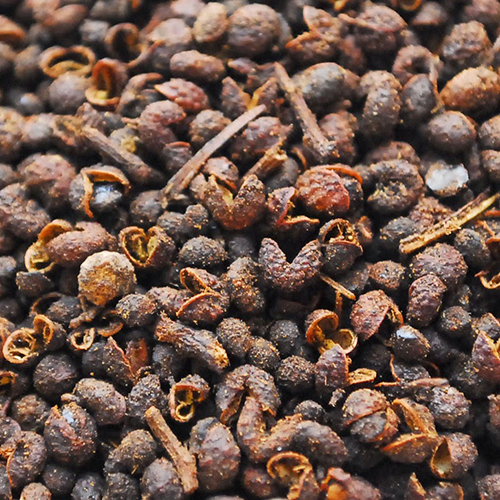
Timur Pepper
Hailing from the same family as Szechuan peppercorn, this 'false flag' pepper is grown in several Himalayan regions. The Timur Pepper has the same tongue-tingling, mouth-numbing properties with intense citrus and grapefruit notes. These citrus qualities make Timur pepper perfect for many Indian and oriental dishes.
Timur grows at high altitudes and is grown by indigenous communities like the Bhotias and Shaukas of Uttarakhand. They have been using it for culinary preparation and medicinal uses for centuries. Timur pepper is believed to have medicinal properties that help purify the blood and augment digestion.
The locals use Timur Pepper to make condiments such as chutney, add it to soups, stews and tomato-based curries. It is added to vegetable preparations and even to fish and pork dishes. Timur seed is separated from its husk, and it is this husk that is used in cooking.
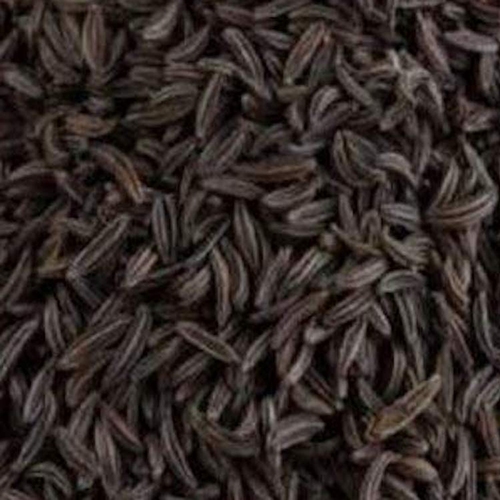
Kaala Jeera
Kaala Jeera, or Black Cumin, is an ancient spice of India. Also called Shahi Jeera, derived from the Persian word syahi which means “black”, the seed of shahi jeera is longer, thinner and darker in colour, compared to regular cumin seeds or jeera.
Grown in the valley of Kashmir and the higher reaches of Uttarakhand using chemical-free processes, the Shahi Jeera has stimulant, antispasmodic, stomachic, carminative, hypolipidemic, antibacterial, astringent, and sedative properties as well.
It is used whole and is roasted in India, where it's added to biryani, bread, chutney, curry, kebab, korma (meats and/or vegetables braised in a spiced sauce), and yoghurt. The Shahi Jeera is also found in some versions of the Indian spice blend, garam masala. Kashmiris use it as a basic ingredient in their cooking.
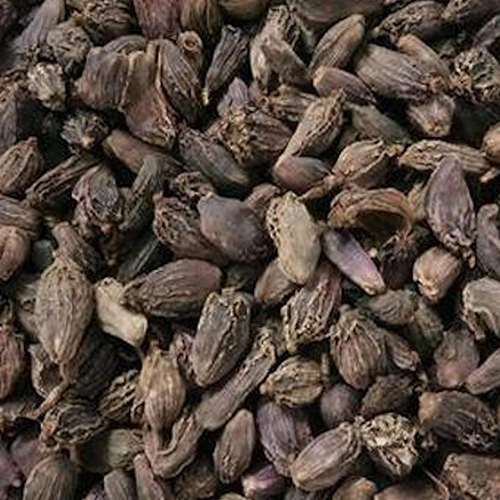
Large Cardamom
Large Cardamom is one of the main cash crops cultivated in Sikkim. India is the largest producer of this unique spice in the world. The people in north-east India use this ancient spice-cum-medicinal herb and it is native to the Eastern Himalayan region.
Small-holder farmers in the West Sikkim districts of Lingchom and Geyzing grow the Large Cardamom with 100% natural processes. It is cultivated mainly in shaded areas and requires moist soil, ideally fertilised with cow dung manure.
It is used as a flavouring agent in dishes like Biriyani and meat preparations. It is an ingredient in curry preparations and spice masala mixtures and is also used in Ayurvedic and Unani medicines.
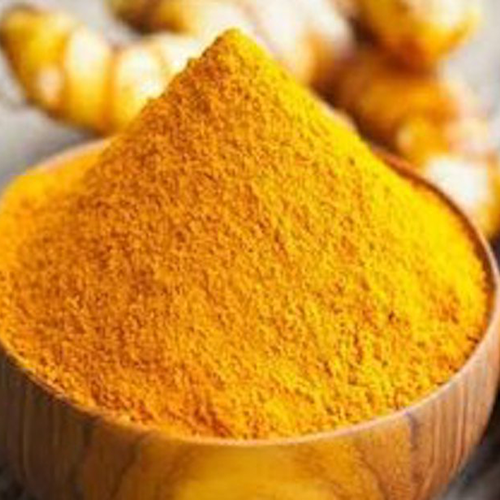
Lakadong Turmeric
Known as the miracle spice across north-east India, Lakadong Turmeric is grown in Lakadong Village of the Laskein Block in Jaintia Hills District of Meghalaya. Its golden hue and aromatic flavour set it apart from other spices and also from other types of turmeric.
Curcumin, the key active ingredient in turmeric, is a miracle compound known for its antioxidant and anti-inflammatory properties and renders a bright yellow colour to the spice. Lakadong turmeric has been proven to have 7% to 12% curcumin content while generic turmeric has 2% to 3% curcumin content.
Grown with 100% natural farming practices by small-holder farmers of Lakadong, the spice is used in cooking, in turmeric lattes and for medicinal use. Its high curcumin value gives it the ability to provide enhanced health benefits: it is anti-inflammatory, an antioxidant, a blood pressure regulator, helps in regulating cholesterol, and helps boost the immune system.

Raja Mircha
Also referred to as King Chilli and Bhoot Jolokia, Raja Mircha has one of the highest ratings in terms of Scoville Heat Units (SHUs), making it one of the world's hottest chillies. Indigenous to Nagaland in north-east India, this chilli is accorded a GI tag (#109) for its unique and extremely high potency.
It is believed to have originated in the Zeliangrong area of Nagaland and is extensively grown in Peren, Mon, Kohima and Dimapur. Also called Naga Mircha, the Raja Mircha is small in size, taking on a brilliant red colour upon maturing. It is very sensitive to weather conditions and needs to be grown in in chemical-free soil that has the right quantity of water.
The Raja Mircha has an appealing aroma and distinctive pungency. It is consumed either in the fresh or dried form in every Naga household. The chillies are also processed into powder and also made into pickles and sauces.